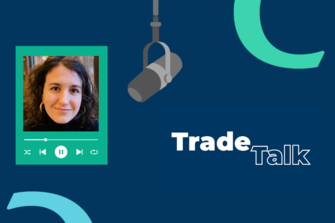#חדשות הקבוצה
"הליבה של הערך המוסף שלנו הוא נתונים"
בראיון שנערך לאחרונה עם Le Revenu, קסאבייר דוראנד, מנכ"ל Coface, חולק את מחשבותיו על ניהול סיכונים, אתגרים כלכליים עכשוויים והמקום והתפקיד של נתונים וחדשנות בניתוח סיכונים ומניעה.

חקור את לוח הסיכונים המקיף של Coface, המספק הערכות סיכונים מעמיקות עבור 160 מדינות ו-13 מגזרים בתעשייה כדי לקבל החלטות אסטרטגיות
#חדשות הקבוצה
בראיון שנערך לאחרונה עם Le Revenu, קסאבייר דוראנד, מנכ"ל Coface, חולק את מחשבותיו על ניהול סיכונים, אתגרים כלכליים עכשוויים והמקום והתפקיד של נתונים וחדשנות בניתוח סיכונים ומניעה.
#חדשות הקבוצה
כשחקן מוביל עולמי בניהול סיכוני אשראי מסחרי במשך יותר מ-75 שנים, Coface עוזרת ל-100,000 חברות לצמוח על פני כ-200 שווקים בינלאומיים. גלה כיצד Coface עוזרת לך לסחור בצורה חכמה יותר.
#חדשות הקבוצה
Coface משיקה את "Power the Core" אשר תעמיק ותרחיב את הזיכיון של Coface.
דוחות מידע הם חיוניים לחיזוי סיכונים עסקיים, אך הם גם כלים מעשיים התומכים בניהול עסקי יעיל. חיפוש לקוחות פוטנציאליים, מכירות, שיווק, ביקורת פיננסית, הבטחת שרשרת האספקה או האצת תהליכי הכרת הלקוח (KYC) - פתרונות קבלת החלטות אלה מנחים אתכם דרך כל שלב בעסק שלכם.
#הפתרונות שלנו
בפרק החדש הזה בסדרת "נתונים וטכנולוגיה @Coface", יואן מורן פותח לנו דלת לעולם היומיומי שלו: עולם אבטחת הסייבר. החל מניהול אירועים בזמן אמת, דרך אסטרטגיות מבוססות בינה מלאכותית לזיהוי מוקדם, וכלה בהערכת סיכונים תפעוליים ופיננסיים, גלו מה מתרחש מאחורי הקלעים של ההגנה הדיגיטלית של Coface, ובואו לחקור את האתגרים בתחום הסייבר המעצבים את עתיד הפיננסים.
#הפתרונות שלנו
מאז כניסתה לפעילות לפני יותר משנה, Coface סיפקה תובנות עסקיות יקרות ערך כך ש-Argent Energy יכולה להעריך לקוחות פוטנציאליים ולקבל החלטות מהירות אך יעילות לתמיכה בפעילותה הבריטית והבינלאומית.
#פרסומים כלכליים
לאחר כמעט שלושה עשורים של דפלציה, יפן חווה עלייה מתמשכת במחירים מאז 2022, מה שמסמן נקודת מפנה אפשרית לכלכלתה. שלב הרפלציה הזה נגרם בתחילה על ידי גורמים חיצוניים כמו זינוק במחירי הסחורות והחלשת הין, אך כעת התפתח לדינמיקה מקומית המונעת על ידי צמיחת שכר ועלייה במחירי השירותים.
#פרסומים כלכליים
ב-27 ביולי 2025, דונלד טראמפ ואורסולה פון דר ליין הכריזו על הסכם הקובע תעריף בסיסי של 15% על רוב המוצרים האירופיים הנכנסים לארצות הברית. הפשרה הלא מאוזנת הזו נמנעת מהגרוע ביותר אך מחלישה עוד יותר את התחרותיות האירופית.
#פרסומים כלכליים
המהדורה התשיעית של סקר Coface על התנהגות התשלומים של חברות גרמניות מצביעה על הידרדרות משמעותית בתנאי התשלום, על רקע אי-ודאות פוליטית והחרפה במתיחות הגיאופוליטית. עם זאת, ביחס למדינות אחרות שנבדקו בסקר של Coface, גרמניה עדיין בולטת לטובה עם תנאי תשלום ודחיות תשלום מהקצרים ביותר.
דוחות מידע הם חיוניים לחיזוי סיכונים עסקיים, אך הם גם כלים מעשיים התומכים בניהול עסקי יעיל. חיפוש לקוחות פוטנציאליים, מכירות, שיווק, ביקורת פיננסית, הבטחת שרשרת האספקה או האצת תהליכי הכרת הלקוח (KYC) - פתרונות קבלת החלטות אלה מנחים אתכם דרך כל שלב בעסק שלכם.
#עצת המומחה
הכלכלה האיטלקית ממשיכה להיאבק למרות אינדיקטורים חיוביים בתחום התעסוקה והכספים הציבוריים. מאחורי נתונים מעודדים מסתתרת מציאות של צמיחה שברירית, פריון נמוך ואתגרים מבניים שמונעים התאוששות מלאה.
#עצת המומחה
בפרק האחרון של **Trade Talk**, אנו צוללים לתוך תפקידו הקריטי של האשראי המסחרי ביציבותן של כלכלות מתעוררות בזמן זעזועים מוניטריים שמגיעים מהפדרל ריזרב האמריקאי. הצטרפו אל מֵלינה לונדון, כלכלנית וחוקרת, כדי להבין כיצד אשראי בין-חברתי עשוי לשמש חיץ בפני חוסר יציבות פיננסית.
הערכות הסיכונים העולמיות של Coface עבור 160 מדינות ו-13 מגזרים.
צלול לתוך עולם הסחר העולמי עם הפודקאסט Trade Talk של Coface. חקור דיונים מרתקים עם מומחי סחר, חקור את הדינמיקה של השוק וחשוף אסטרטגיות לצמיחה.
שירותים מקוונים ללקוחות
פורטל לקוחות - CofaNet
פלטפורמה מקוונת של Coface לניהול החובות המסחריים שלך. ניטור מלא של הסיכונים שלך. גישה ישירה לכל הכלים על פי החוזים שלך.
פורטל API
תפסיק ללהטט בין יישומי תוכנה. חקור את קטלוג ה-API של Coface ואת הפתרונות המשולבים עבור Icon by Coface וביטוח אשראי מסחרי.






